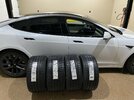1) The 19" tires also have a much taller sidewall which allows for more flex when the pressure is applied to that thin strip of the tire. 20" aftermarket setups also have more sidewall flex.
2) see above
3) see above (again)
4) when the majority of the weight of the car is placed on a thin strip of the tire, obviously it is going to wear more. Do you think you will have even wear across the surface if the majority of the weight is placed in one area? If so, can you explain your thoughts on why all cars benefit from tire rotations to extend the life of the tires?
5) it doesn't happen to only Michelins, it has happened to other brands. I have a set of 21" goodyear F1's on my car now that has also started to wear down my left rear inside tire after just 1,000 miles or so, just like it wore down the left rear inside OEM 21" Michelin. - Ever stop to think on why almost every single person also only has an issue with 1 tire? and not both? It's a car alignment issue, that's why.
I'm in the process of ruining these goodyear F1's just to prove a point so people get over the 'blame Michelin' thing on here. I'm going to run it down until it cuts into the tire, but not to the point it has a blowout. But, I also reckon that people have already made up their mind that this is Michelin's fault, and they will write mine off as an outlier, so I have an extra set of rear F1's to do this not once, but twice to stop this ridiculous debate.
Absent any data, how can you possibly know what you posit in Item 4?
You wrote:
4) when the majority of the weight of the car is placed on a thin strip of the tire, obviously it is going to wear more. Do you think you will have even wear across the surface if the majority of the weight is placed in one area?
IF this were the case, which I find absurd, it would create massive wear on the wheel bearings and we'd be hearing of wheel bearings failing left and right. It makes little sense, especially given the redesigned suspension on the Palladium MS. Likewise, the wear is NOT occurring at the tread face, even on the inside edge, with most/all tires showing consistent wear across the tire.
Instead, we have many photographs of tearing and delamination at the inner sidewall and tread junction. (There were suspicions of scoring from the suspension suggested early on, that's how "off tread" the damage is.)
Tires are complicated, despite their appearance. Thus, I suggest we leave the tire engineering to the experts and just look at the facts we have before us:
1. Tires with significant tread left are coming apart at the inner sidewall and tread junction.
2. Thus far, there are no reports of this occurring with any OEM 19" Pirelli tires, despite identical (AFAIK) suspension settings.
3. There is a massive dearth of 21" Michelin replacement tires, likely because a LOT of tires are failing.
4. There appears to be minimal to no action by NHTSA or Michelin to replace these tires, thus far. We sincerely hope there will be a recall or service action before there's an accident, especially with the first Plaid shipments to Germany, for Autobahn driving, arriving about now . . . . Give them a year or two in service, combine with someone's very bad luck, and we'll see some horrific headlines if this problem isn't addressed.



